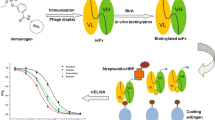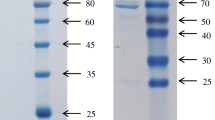Abstract
A single-chain variable fragment antibody against herbicide, 2,4-dichlorophenoxyacetic acid (2,4-D-scFv) has been successfully expressed in the hemolymph of silkworm larvae using a rapid Bombyx mori nucleopolyhedrovirus (BmNPV) bacmid DNA system. Variable heavy- and light-chain domains were cloned directly from the cDNA of the hybridoma cell line 2C4 and assembled together with flexible peptide linker (Gly4Ser)3 between two domains. The yield of functional 2,4-D-scFv after purification was 640 μg per 30 ml of hemolymph, which is equivalent to 21.3 mg per liter of hemolymph. The characterization of 2,4-D-scFv using an indirect competitive enzyme-linked immunosorbent assay (icELISA) revealed that it has wide cross-reactivities against 2,4,5-trichlorophenoxyacetic acid (65.5%), 2,4-dichlorophenol (47.9%), and 2,4-dichlorobenzoic acid (26.0%), making it possible to apply 2,4-D-scFv to icELISA for detecting/determining 2,4-D and its metabolites. Judging from its cost and time requirements and its ease of handling, this BmNPV bacmid DNA expression system is more useful for expressing functional scFv than bacterial systems, which frequently require costly and time-consuming refolding.





Similar content being viewed by others
Abbreviations
- ABTS 2:
-
2′-Azinobis (3-ethylbenzothiazoline-6-sulfonic acid ammonium salt
- BmNPV:
-
Bombyx mori nucleopolyhedrovirus
- bp:
-
Base pairs
- CR:
-
Cross-reactivities
- 2,4-D:
-
2,4-Dichlorophenoxyacetic acid
- 2,4-D-scFv:
-
Single-chain variable fragment antibody against 2,4-D
- ELISA:
-
Enzyme-linked immunosorbent assay
- HMSS:
-
Honeybee melittin signal sequence
- HRP:
-
Horseradish peroxidase
- K D :
-
Dissociation constant
- PBS:
-
Phosphate-buffered saline
- scFv:
-
Single-chain variable fragment
- VH:
-
Heavy chain variable region
- VL:
-
Light-chain variable region
References
Tuschl, H., & Schwab, C. (2003). Cytotoxic effects of the herbicide 2,4-dichlorophenoxyacetic acid in HepG2 cells. Food and Chemical Toxicology, 41, 385–393.
Sulik, M., Kisielewski, W., Szynaka, B., Kemona, A., Sulkowska, M., & Baltaziak, M. (1998). Morphological changes in mitochondria and lysosomes of hepatocytes in acute intoxication with 2,4-dichlorophenoxyacetic acid (2,4-D). Materia Medica Polona, 30, 16–19.
Osaki, K., Mahler, J. F., Hasemann, J. K., Moomaw, C. R., Nicolette, M. L., & Nyska, A. (2001). Unique renal tubule changes induced in rats and mice by the peroxisome proliferators 2,4-dichlorophenoxyacetic acid (2,4-D) and WY-14643. Toxicologic Pathology, 29, 440–450.
Charles, J. M., Hanley, T. R., Jr., Wilson, R. D., van Ravenzwaay, B., & Bus, J. S. (2001). Developmental toxicity studies in rats and rabbits on 2,4-dichlorophenoxyacetic acid and its forms. Toxicological Sciences, 60, 121–131.
Barnekow, D. E., Hamburg, A. W., Puvanesarajah, V., & Guo, M. (2000). Metabolism of 2,4-dichlorophenoxyacetic acid in laying hens and lactating goats. Journal of Agricultural and Food Chemistry, 49, 156–163.
Aydin, H., Ozdemir, N., & Uzunoren, N. (2005). Investigation of the accumulation of 2,4-dichlorophenoxyacetic acid (2,4-D) in rat kidneys. Forensic Science International, 153, 53–57.
Beeson, M. D., Driskell, W. J., & Barr, D. B. (1999). Isotope dilution high-performance liquid chromatography/tandem mass spectrometry method for quantifying urinary metabolites of atrazine, malathion, and 2,4-dichlorophenoxyacetic acid. Analytical Chemistry, 71, 3526–3530.
Miura, N., Ogata, K., Sasaki, G., Uda, T., & Yamazoe, N. (1997). Detection of morphine in ppb range by using SPR (surface-plasmon-resonance) immunosensor. Chemistry Letters, 8, 713–714.
Horacek, J., & Skladal, P. (2000). Effect of organic solvents on immunoassays of environmental pollutants studied using a piezoelectric biosensor. Analytica Chimica Acta, 412, 37–45.
Green, T. M., Charles, P. T., & Anderson, G. P. (2002). Detection of 2,4,6-trinitrotoluene in seawater using a reversed-displacement immunosensor. Analytical Biochemistry, 310, 36–41.
Taitt, C. R., Anderson, G. P., Lingerfelt, B. M., Feldstein, M. J., & Ligler, F. S. (2002). Nine-analyte detection using an array-based biosensor. Analytical Chemistry, 74, 6114–6120.
Kim, S. J., Gobi, K. V., Tanaka, H., Shoyama, Y., & Miura, N. (2008). A simple and versatile self-assembled monolayer based surface plasmon resonance immunosensor for highly sensitive detection of 2,4-D from natural water resources. Sensors and Actuators B, 130, 281–289.
Tanaka, H., Yan, S., Miura, N., & Shoyama, Y. (2003). Preparation of anti-2,4-dichlorophenol and 2,4-dichlorophenoxyacetic acid monoclonal antibodies. Cytotechnology, 42, 101–107.
Rando, R. F., & Notkins, A. L. (1994). Production of human monoclonal antibodies against rabies virus. Current Topics in Microbiology and Immunology, 187, 195–205.
Kortt, A. A., Dolezal, Q., Power, B. E., & Hudson, P. J. (2001). Dimeric and trimeric antibodies: high avidity scFvs for cancer targeting. Biomolecular Engineering, 18, 95–108.
Penichet, M. L., & Morrison, S. L. (2001). Antibody-cytokine fusion proteins for the therapy of cancer. Journal of Immunological Methods, 248, 91–101.
Adams, G. P., Shaller, C. C., Chappell, L. L., Wu, C., Horak, E. M., Simmons, H. H., et al. (2000). Delivery of the alpha-emitting radioisotope bismuth-213 to solid tumors via single-chain Fv and diabody molecules. Nuclear Medicine and Biology, 27, 339–346.
Maenda, S. (1989). Expression of foreign genes in insects using baculovirus vectors. Annual Review of Entomology, 34, 351–372.
Motohashi, T., Shimojima, T., Fukunaga, T., Maenaka, K., & Park, E. Y. (2005). Efficient large-scale protein production of larvae and pupae of silkworm nuclear polyhedrovirus (BmNPV) bacmid system. Biochemical and Biophysical Research Communications, 326, 564–569.
Krebber, A., Bornhauser, S., Burmester, J., Honegger, A., Bosshard, H. R., & Pluckthun, A. (1997). Reliable cloning of functional antibody variable domains from hybridomas and spleen cell repertoires employing a reengineered phage display system. Journal of Immunological Methods, 201, 35–55.
Bradford, M. M. (1976). A rapid and sensitive method for the quantitation of microgram quantities of protein utilizing the principle of protein-dye binding. Analytical Biochemistry, 72, 248–254.
Friguet, B., Chaffotte, A. F., Djavadi-Ohaniance, L., & Goldberg, M. E. (1985). Measurements of the true affinity constant in solution of antigen-antibody complexes by enzyme-linked immunosorbent assay. Journal of Immunological Methods, 77, 305–319.
Weiler, E. W., & Zenk, M. H. (1976). Radioimmunoassay for the detection of digoxin and related compounds in Digitalis lanata. Phytochemistry, 15, 1537–1545.
Putalun, W., Taura, F., Qing, W., Matsushita, H., Tanaka, H., & Shoyama, Y. (2003). Anti-solasodine glycoside single-chain Fv antibody stimulates biosynthesis of solasodine glycoside in plants. Plant Cell Report, 22, 344–349.
Lu, Z., Masaki, T., Shoyama, Y., & Tanaka, H. (2006). Construction and expression of a single-chain fragment against pharmacologically active paeoniflorin in Escherichia coli, and its potential use in an enzyme-linked immunosorbent assay. Planta Medica, 72, 151–155.
Pongkitwitoon, B., Sakamoto, S., Morinaga, O., Juengwatanatrakul, T., Shoyama, Y., Tanaka, H., et al. (2011). Single-chain variable fragment antibody against ginsenoside Re as an effective tool for the determination of ginsenosides in various ginsengs. Journal of Natural Medicines, 65, 24–30.
Sakamoto, S., Taura, F., Putalun, W., Pongkitwitoon, B., Tsuchihashi, R., Morimoto, S., et al. (2009). Construction and expression of specificity-improved single-chain variable fragments against the bioactive naphthoquinone, plumbagin. Biological & Pharmaceutical Bulletin, 32, 434–439.
Acknowledgments
The research in this paper was supported, in part, by the Research Fellowship of the Japan Society for the Promotion of Science for Young Scientists. This work was also funded by a Grant in Aid from the Japan Society for the Promotion of Science Asian CORE Program of the Ministry of Education, Culture, Sports, Science, and Technology of Japan.
Author information
Authors and Affiliations
Corresponding author
Rights and permissions
About this article
Cite this article
Sakamoto, S., Pongkitwitoon, B., Nakamura, S. et al. Construction, Expression, and Characterization of a Single-Chain Variable Fragment Antibody Against 2,4-Dichlorophenoxyacetic Acid in the Hemolymph of Silkworm Larvae. Appl Biochem Biotechnol 164, 715–728 (2011). https://doi.org/10.1007/s12010-011-9168-4
Received:
Accepted:
Published:
Issue Date:
DOI: https://doi.org/10.1007/s12010-011-9168-4




